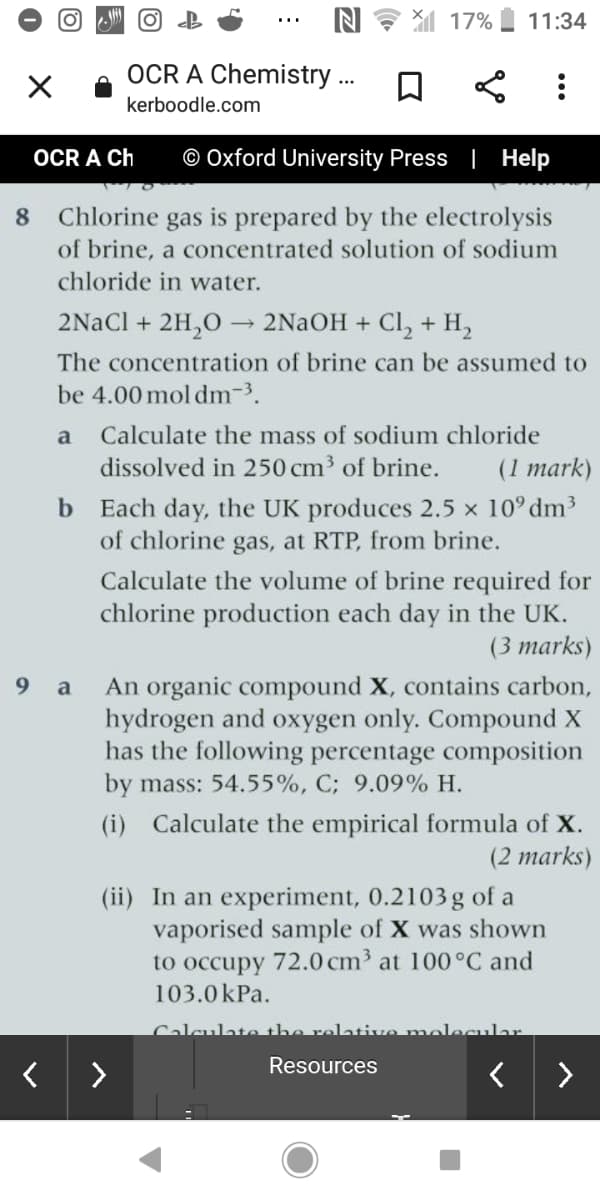Chlorine gas is prepared by the electrolysis of brine, a concentrated solution of sodium chloride in water. 2NaCl + 2H,0 2NAOH + CI, + H, The concentration of brine can be assumed to be 4.00 mol dm-3. a Calculate the mass of sodium chloride dissolved in 250 cm3 of brine. (1 mark) b Each day, the UK produces 2.5 x 10° dm3 of chlorine gas, at RTP, from brine.
Chlorine gas is prepared by the electrolysis of brine, a concentrated solution of sodium chloride in water. 2NaCl + 2H,0 2NAOH + CI, + H, The concentration of brine can be assumed to be 4.00 mol dm-3. a Calculate the mass of sodium chloride dissolved in 250 cm3 of brine. (1 mark) b Each day, the UK produces 2.5 x 10° dm3 of chlorine gas, at RTP, from brine.
Chapter18: Electrochemistry
Section: Chapter Questions
Problem 8RQ
Related questions
Question
Answer 8b please simple and clear please

Transcribed Image Text:N 17%
11:34
OCR A Chemistry .
kerboodle.com
OCR A Ch
© Oxford University Press | Help
8.
Chlorine
gas
is prepared by the electrolysis
of brine, a concentrated solution of sodium
chloride in water.
2NaCl + 2H,O
2NaOH + Cl, + H,
The concentration of brine can be assumed to
be 4.00 mol dm-3.
a
Calculate the mass of sodium chloride
dissolved in 250 cm3 of brine.
(1 mark)
b Each day, the UK produces 2.5 x 10° dm3
of chlorine gas, at RTP, from brine.
Calculate the volume of brine required for
chlorine production each day in the UK.
(3 marks)
An organic compound X, contains carbon,
hydrogen and oxygen only. Compound X
has the following percentage composition
by mass: 54.55%, C; 9.09% H.
9.
a
(i) Calculate the empirical formula of X.
(2 marks)
(ii) In an experiment, 0.2103g of a
vaporised sample of X was shown
to occupy 72.0 cm³ at 100°C and
103.0kPa.
Calculate the relative molecular.
Resources
Expert Solution
This question has been solved!
Explore an expertly crafted, step-by-step solution for a thorough understanding of key concepts.
This is a popular solution!
Trending now
This is a popular solution!
Step by step
Solved in 2 steps

Knowledge Booster
Learn more about
Need a deep-dive on the concept behind this application? Look no further. Learn more about this topic, chemistry and related others by exploring similar questions and additional content below.Recommended textbooks for you


Chemistry: An Atoms First Approach
Chemistry
ISBN:
9781305079243
Author:
Steven S. Zumdahl, Susan A. Zumdahl
Publisher:
Cengage Learning

Chemistry
Chemistry
ISBN:
9781305957404
Author:
Steven S. Zumdahl, Susan A. Zumdahl, Donald J. DeCoste
Publisher:
Cengage Learning


Chemistry: An Atoms First Approach
Chemistry
ISBN:
9781305079243
Author:
Steven S. Zumdahl, Susan A. Zumdahl
Publisher:
Cengage Learning

Chemistry
Chemistry
ISBN:
9781305957404
Author:
Steven S. Zumdahl, Susan A. Zumdahl, Donald J. DeCoste
Publisher:
Cengage Learning

Principles of Instrumental Analysis
Chemistry
ISBN:
9781305577213
Author:
Douglas A. Skoog, F. James Holler, Stanley R. Crouch
Publisher:
Cengage Learning

Chemistry & Chemical Reactivity
Chemistry
ISBN:
9781337399074
Author:
John C. Kotz, Paul M. Treichel, John Townsend, David Treichel
Publisher:
Cengage Learning

Chemistry for Engineering Students
Chemistry
ISBN:
9781337398909
Author:
Lawrence S. Brown, Tom Holme
Publisher:
Cengage Learning